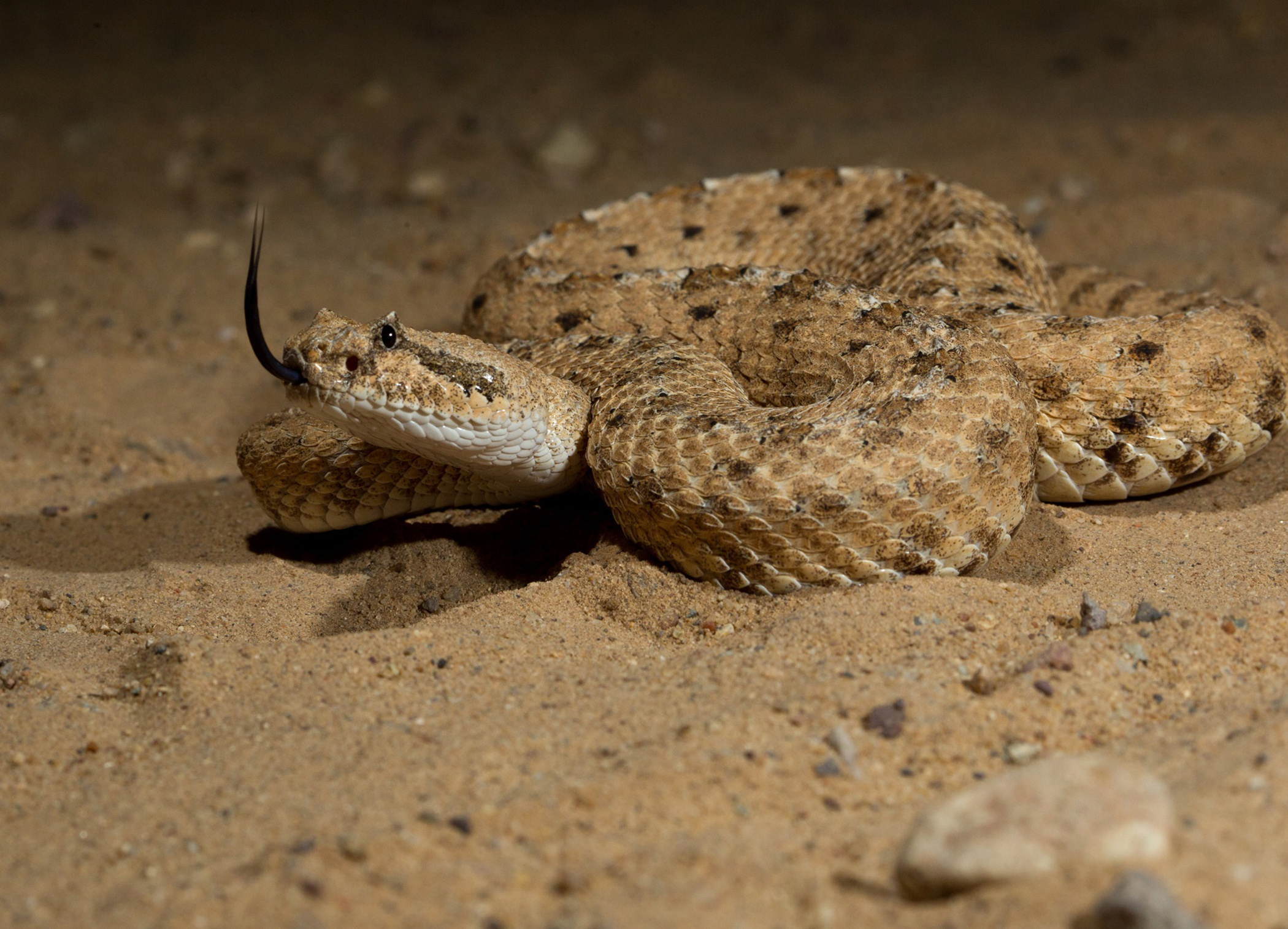The mesmerizing flow of a sidewinder moving obliquely across desert sands has captivated biologists for centuries and has been variously studied over the years, but questions remained about how the snakes produce their unique motion. Sidewinders are pit vipers, specifically rattlesnakes, native to the deserts of the southwestern United States and adjacent Mexico.
Scientists had already described the microstructure of the skin on the ventral, or belly, surface of snakes. Many of the snakes studied, including all viper species, had distinctive rearward facing “microspicules” (micron-sized protrusions on scales) that had been interpreted in the context of reducing friction in the forward direction—the direction the crawling snake—and increasing friction in the backward direction to reduce slip.
Considered through the lens of a sidewinder’s peculiar form of locomotion, however, it seemed that these microspicules would not function in the same manner. But no one had examined the microstructure of sidewinders, nor of a handful of unrelated African vipers that also sidewind.
Working with naturally-shed skins collected from snakes in zoos, researchers used atomic force microscopy to visualize and measure the microstructures of these scale protrusions in three species of sidewinding vipers as well as many other viper species for comparison. The results of the research, published this week in the journal Proceedings of the National Academy of Sciences, found that indeed the sidewinders have a unique structure distinct from other snakes.
The microspicules were absent in the African sidewinding species and reduced to tiny nubbins in the North American sidewinder. All three snakes also had distinctive crater-like micro-depressions producing a distinctive texture not seen in other snakes.
Daniel Goldman, Dunn Family Professor of Physics at the Georgia Institute of Technology, and Jennifer Rieser, working as a postdoctoral researcher in Goldman’s group and currently an assistant professor in the Department of Physics at Emory University, developed mathematical models to test how both the typical texture of rearward-directed microspicules and spicule-less cratered texture function as snakes interact with the ground. The models revealed that the microspicules would actually impede sidewinding, explaining their evolutionary loss in these species.
The models also revealed an unexpected result that microspicules function to improve performance of snakes that use lateral undulation to move. Lateral undulation is the typical side-to-side mode locomotion used by the majority of snake species. “This discovery adds a new dimension to our knowledge of the functionality of these structures, that is more complex than the previous ideas,” said Joseph Mendelson, director of research at Zoo Atlanta and adjunct associate professor in the Georgia Tech School of Biological Sciences.
The models indicate that the microspicules act a bit like corduroy fabric. “Friction is low when you run your finger along the length of the furrowed fabric—consistent with previous work—but the furrows produce significant friction when you move your finger sideways across the fabric texture,” said Goldman. The functionality of the distinct craters remains a mystery.
The findings could be important to the development of future generations of robots able to move across challenging surfaces such as loose sand. “Understanding how and why this example of convergent evolution works may allow us to adapt it for our own needs, such as building robots that can move in challenging environments,” Rieser said.
In terms of anatomy, this was a classic example of convergent evolution between a pair of snake species in Africa and a very distantly related snake in North America, Mendelson noted. Biogeographic reconstructions conducted by Jessica Tingle, a doctoral student at University of California Riverside, indicated that the African snakes are evolutionarily much older than the North American sidewinder, suggesting that the sidewinders represented an earlier phase in adaptation for sidewinding.
Tai-De Li, then at Georgia Tech in the lab of Prof Elisa Riedo and now at the City University of New York, did the AFM measurements.
Drawing from the fields of evolutionary biology, living systems physics, and mathematical modelling, the team produced a study that explains some aspects of what these microstructures on the bellies of snakes do and how they evolved in snakes.
“Our results highlight how an integrated approach can provide quantitative predictions for structure-function relationships and insights into behavioral and evolutionary adaptions in biological systems,” the authors wrote.
This research was supported by the Georgia Tech Elizabeth Smithgall Watts Fund; National Science Foundation Physics of Living Systems Grants PHY-1205878 and PHY-1150760; and Army Research Office Grant W911NF-11-1-0514. Any opinions, findings, and conclusions or recommendations expressed in this material are those of the authors and do not necessarily reflect the views of the sponsoring agencies.
CITATION: Jennifer M. Rieser, Tai-De Li, Jessica L. Tingle, Daniel I. Goldman, and Joseph R. Mendelson III, “Functional consequences of convergently evolved microscopic skin features on snake locomotion.” (Proceedings of the National Academy of Sciences, 2021)
Research News
Georgia Institute of Technology
177 North Avenue
Atlanta, Georgia 30332-0181 USA
Media Relations Contact: John Toon (404-894-6986); (jtoon@gatech.edu).
For More Information Contact
John Toon
Research News
(404) 894-6986





